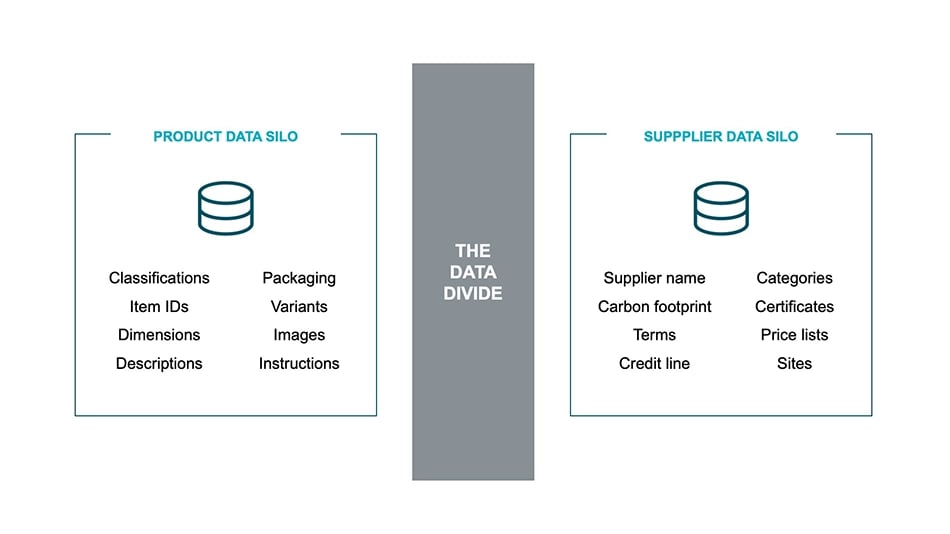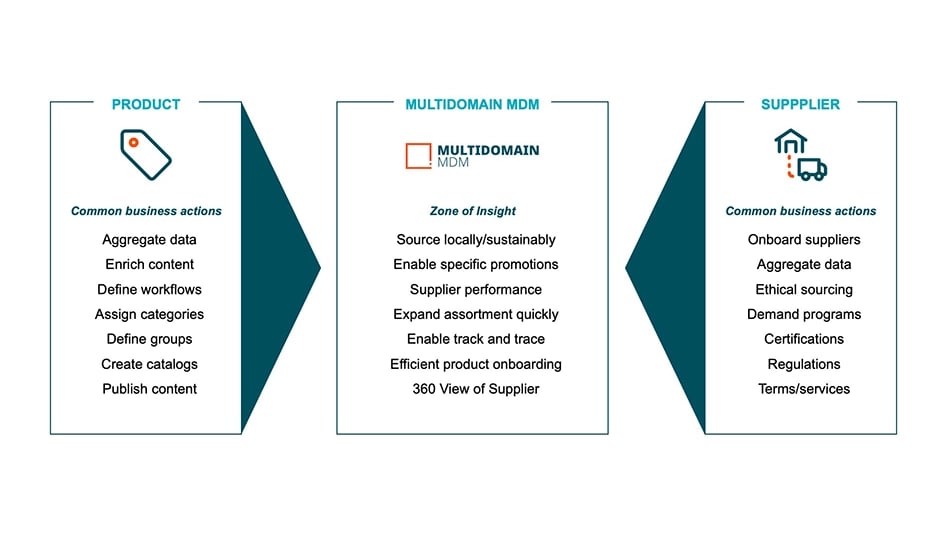Data silos are a huge problem for your ability to collaborate, operate efficiently and deliver excellent customer experiences. However, multidomain master data management can bring your data silos together and create new zones of insight.
This article will explore the relationship between product and supplier master data domains.
Different master data domains, such as product data or supplier data, are typically stored and managed in separate systems by different departments using proprietary data policies. From this practice, that can seem logical from a business point-of-view, data silos emerge and tend to develop indigenous governance rules. Such data silos are problematic when you want to share data across departments. Fortunately, your master data domains can have relationships and commonalities that make joint data governance relevant.
Bringing data domains together can reveal new insights into certain parts of the business and deliver new levels of data transparency that can help power your business to the next level of delivering superior customer experiences. We will use the product data domain as a foundational start point when exploring domain relationships due to its heterogenous application across multiple industries.
This blog post builds upon the concepts that were introduced in a previous article, entitled Multidomain MDM vs. Multiple Domain MDM. This is must-read material to get you into the ‘multidomain’ mindset.

What is a data silo?
A data silo can be any database or business system that stores and manages data according to proprietary rules and often disconnected from other business systems. Common types of data silos include:
- Legacy Apps
- ERP
- CRM
- Supply chain management
- Regulatory information management
- Marketing automation
- Customer data platforms (CDP)
- Analytics platforms
- Spreadsheets
Yes, even spreadsheets. The disconnectedness makes data silos problematic if other departments in the enterprise use their own systems to manage the same data. Then your enterprise data is no longer synchronized. Data silos are also organisational silos. Decentralized decision making across departments, lines of business and geographies, often leads to data being duplicated in multiple locations. The result: a broad spectrum of hybrid environments with widely distributed, siloed data, all on their own unique path to becoming a customer-centric, responsive and agile enterprise. As you might guess, mergers and acquisitions are a common root cause of data silos.
The data divide between the product data silo and the supplier data silo
It’s not uncommon within an enterprise to find detailed information about the products you sell in one system, but to then find out information about the supplier of those products you need to reference in another system. This creates a data divide that limits real-time insights that could improve the experiences people have with your products and company.

Product information must be fit for purpose
When organisations work within the product data domain, they are essentially ensuring that product information is compliant to support efficient commercial business processes such as marketing, sales and logistics. Products can be easily identified with unique identifiers, they can be organized to support online selling, they have compelling descriptions for merchants, they have accurate dimensions for store placement/shipping and have useful instructions for consumers.
Supplier information must support your business goals
When working within the supplier data domain, organisations are looking to ensure that they have the correct trading relationships in place to ensure they can fulfil their commitments to their customers, whether that is receiving raw materials for manufacturing or finished goods for sale. These relationships can depend on contractual agreements, credit ratings, compliance, pricing, category of goods, location proximity, ethical standards and much more.
It’s easy to see how working with master data from each of these domains can be done independently. It’s also unlikely that the same job role is working and interacting with these separate data domains. This is where data becomes siloed. However, there are overlaps in data attribution and there are relationships between these data domains, they’re just not established or connected.
Siloed data hampers customer experiences and business agility
Silos make data susceptible to become duplicated across different systems, maintained separately and governed independently. It then becomes problematic to merge the siloed data later when the business needs to combine data from different systems to answer questions like:
- How many suppliers do we have providing similar items? Who are they and how do the items compare with each other?
- Can we select suppliers of items where their carbon footprint is below a certain threshold?
- Can we introduce supplier score-carding for availability, supply and quality of product item data?
- Can we implement efficient track-and-trace procedures for recall, return and compensation?
- Can we obtain better procurement costs through understanding the supplier organisation better and their item assortment across operating companies?
- How can we shorten the time it takes to onboard new suppliers and get to market quicker than the competition?
Your ERP does not provide data insight
Typical ERP systems are ineffective when attempting to get these answers. They are very specific in nature and designed to focus on processes for effectively managing a company’s resources. ERPs were never designed to reveal these types of insight into business data.
The modern enterprise no longer has a single ERP system, they have an array of specialised systems and applications that improve and enhance different business operations. This inevitably creates data friction where data becomes incompatible or inaccessible.
A lack of business oversight in data governance transparency may be what is preventing access to the right data. Governance provides the ability to certify data as fit for purpose, the data set that describes how products relate to suppliers for specific business purposes, such as predictive analytics, robotic process automation and compliance. The data describing these relationships is in most cases, highly insightful and therefore, valuable. As such, it lives in areas that we describe as zones of insight.
The solution: Enabling zones of insight between product and supplier domains
Revealing zones of insight is only possible by bringing together master data from different domains. There are three ways this can achieved:
-
Push separate streams of data to business applications that can model insights as part of its core functionality
-
Push separate streams of data to an analytics platform system and model the insights manually
-
Use a multidomain master data management solution with referential modelling capabilities
Common problems associated with siloed business applications
These solutions perform specific functions that address key business processes within an organisation, for example an enterprise resource planning (ERP) system, a customer relationship management (CRM) system or a supply chain management (SCM) system. These systems function using multidomain data. They rely upon accurate and consistent data to perform their operations efficiently and effectively. In large organisations, data that is common amongst business systems can become inconsistent which means insights drawn from each system can differ. This is due to application specific data governance policies and lack of integration or synchronisation between systems. Another drawback is that these systems can only provide pre-configured insights because the applications are prescriptive in nature.
Your analytics platform needs accurate data, too
Using an analytics platform is a common method for modelling and generating business insights. Business intelligence tools allow you to load data from multiple sources, link that data through unique keys and then generate insights for the business to act upon. The results of which could lead to new business actions that need to be incorporated into existing line-of-business (LoB) systems or create the requirement to acquire more specialised LoB solutions.
Analytics platforms model historical data. They do not allow an organisation to act on real-time insights, unless of course they are embedded into a line-of-business application and configured to receive real-time event data.
A major drawback of analytics engines is that in order to model accurate insights, data received from multiple systems will need to be adjusted so apples are matching apples. Attribute definitions will need to be standardized and lists of values (LOVs) matched. This is necessary due to differing governance policies from the source systems. This process can be complex and time-consuming and won’t be a single-time effort.
Multidomain master data management offers a single source of truth
A multidomain master data approach takes a view of all master domain data used within an organisation, the data within line-of-business systems and the data that moves between systems and processes. The promise of multidomain master data management is access to a single source of truth from all touch points within the enterprise. With a multidomain master data management solution an organisation can implement enterprise-wide governance policies using a single solution and manage all their domain data within a single digital business hub. This provides ultimate transparency of cleansed, consistent, and accurate master data that can then be synchronised with line-of-businesses systems according to business policies and operating procedures.
When master data is stored within a digital business hub, references between data can be easily modelled to reveal real-time multidomain zones of insight. This allows the business to act immediately upon the data and take advantage of the ‘now’ to deliver superior customer experiences.
What’s more, the digital business hub can also feed embedded or standalone analytics solutions for historical data modelling and business intelligence.
Use case retail:
The backend of a retailer's system shows a list of items (product domain) available in a specific store (location domain) that have not been supplied by a certain company (supplier domain). This insight could enable a retailer to establish what level of competition exists for a certain product in store, to make a decision on whether to introduce a new item from a specific supplier. These types of insight can enable specific promotions.
Not all master data management solutions are equal. This scenario is only possible with a solution that uses one tool, one platform and one skill-base. Managing master data domains using different solutions for different domains is a master data management problem in itself.
Your previous data silo problems are now replaced by a zone of insight
The diagram below shows how the data divide can be replaced with a zone of insight:

If your business is looking for answers to questions that reside within the data divide, then a multidomain master data management solution will shine a light on data insights that can move your business to the next level.
EXPLORE
Multidomain Master Data Management






































































































































































































